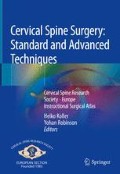Abstract
Surgery can be required even in very young kids to treat many pathologies of the occipito-cervical junction. Reduction of displacement and stabilization need fixation and fusion.
Local anatomy doesn’t allow classical fixation (as hooks or screw due to the size of the vertebrae or remaining growth cartilage). O-C1-C2 or C-C2 wiring may be a solution, even though it has been demonstrated that it was not the better biomechanical construct. A perfect knowledge of the anatomy is necessary.
Surgical Technique:
A cortical graft, after decortication of the posterior arch of C1 and upper part of lamina of C2, is either simply applied or embedded, maintained by the wire.
Tension must be applied on the wire but without:
-
Excessive tension which increases local hyperlordosis and risk of “cheese wire effect”.
-
Insufficiency tension which leaves local kyphosis and risk or graft dislodgement.
Immobilization by halo cast or halo brace is necessary at least 2 months after surgery.
Conclusion:
This easy technique is still used in very young kids and remains helpful in numerous cases.
Access this chapter
Tax calculation will be finalised at checkout
Purchases are for personal use only
Bibliography
Grisel P. Enucléation de l’atlas et torticolis naso-pharingien. Presse Med. 1930;38:50–3.
Gallie WE. Fractures and dislocations of the cervical spine. Am J Surg. 1939;46:494.
Brooks AL, Jenkins EB. Atlanto-axial arthrodesis by the wedge compression method. J Bone Joint Surg Am. 1978;60:279.
Clark CR, Ranawat CS. Posterior cervical (C1-C2) fusion for atlanto-axial subluxation in rheumatoid arthritis. Strat Orthop Surg. 1985;4(1):1.
Wertheim SB, Bohlman HH. Occipitocervical fusion. J Bone Joint Surg Am. 1987;69:833.
Clark CR. Trauma and rheumatoid arthritis of the upper cervical spine. In: Sherk HH et al., editors. The cervical spine: an atlas of surgical procedures. p. 127.
Roy-Camille R, Antonietti P. Arthodèse par greffe C1-C2. Le Rachis. 1-Aspects Fondamentaux, Explorations, Techniques Masson; 1995. p. 423.
Author information
Authors and Affiliations
Editor information
Editors and Affiliations
Rights and permissions
Copyright information
© 2019 Springer Nature Switzerland AG
About this chapter
Cite this chapter
Bancel, P., Shimizu, T. (2019). Upper Cervical Techniques: Pediatric Wiring. In: Koller, H., Robinson, Y. (eds) Cervical Spine Surgery: Standard and Advanced Techniques. Springer, Cham. https://doi.org/10.1007/978-3-319-93432-7_33
Download citation
DOI: https://doi.org/10.1007/978-3-319-93432-7_33
Publisher Name: Springer, Cham
Print ISBN: 978-3-319-93431-0
Online ISBN: 978-3-319-93432-7
eBook Packages: MedicineMedicine (R0)

